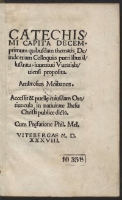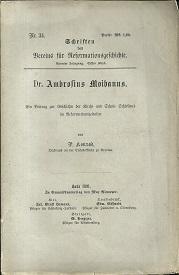Ambrosius Moibanus
Ambrose Moibanus, also Moyben, Moiban, Moybin, Moywen, Mecodiphrus, ( born April 4, 1494 in Breslau, † January 16, 1554 ) was a German humanist, Protestant theologian and reformer.
Life
The son of the shoemaker Georg Moiban and his wife Margarethe came from middle-class family. He attended the parish school of St. Mary Magdalene his hometown, where he drew attention to his talent and he was sent to approximately the tenth year of the Jacobi - parish school in Neisse, the royal seat of the episcopal principality of Neisse. After completing his training Moibanus returned to Breslau, where he became a teacher at the school to Holy corpse.
In 1510 he received the prestigious University of Krakow, emerged from the numerous humanist, poet, mathematician and astronomer. Traditionally, graduated Moibanus the study of the Seven Liberal Arts, which he associated with obtaining the academic degree of Bachelor of Arts graduating liberal Pentecost 1514. In the winter semester 1515 we find him at the University of Vienna, where he continued his philosophical studies at St. Ambrose Salzer 1517 and earned a master's degree of the Philosophical Sciences.
There he gave in 1517 under the humanistic name Ambrosius Mecodiphrus three heroic anthems of the Italian mystic Pico de Mirandola out a poem on the origin of the different religions and a hymn to the mystery of the Holy Trinity with prints, accompanied by a recommendatory Beige sealing of the Hellenist Jacobus Bedrotus Pludentinus. After a scholarship tour of southern Germany, where he met, among others, Johannes Reuchlin, the Council appointed him in Breslau in 1520 to lead the parish school at St. Mary Magdalene. For his students he was there in 1520 a collection of shorter epistles of Erasmus of Rotterdam and 1521 out own Latin grammar " paedia artis Grammaticae ", the " Erasmus ' Libellus de constructione octo partium orationis " is beige prints as syntax
After the death of the bishop, he resigned from the leadership of the cathedral school and instead took the school to the Magdalene Church ( 1643 to Mary Magdalene Gymnasium). In Leipzig he had in 1522 a Latin grammar and other textbooks appear and struggled to raise the level of education. Since his efforts proved unsuccessful, he gave to the Office of Education and devoted himself since 1523 exclusively in Wittenberg theology.
As a friend of the Reformation Moiban had gone early 1520 temporarily Philipp Melanchthon at the University of Wittenberg, to be taught by him about pedagogical issues in relation to Partikularschulen. End of 1521, he went back to Wittenberg, where he witnessed the beginnings of the Wittenberg movement. Since his father was died in 1522, it briefly pulled him back to Breslau, where he returned in 1522 to Wittenberg. On April 16, 1523, he enrolled again in Wittenberg to study theology. His teachers at that time were of course Martin Luther, Caspar Cruciger, Johannes Bugenhagen, Justus Jonas and the elderly. For Joachim Camerarius, Paul Eber and Veit Dietrich, he built up a friendly relationship and changed from a humanist to the Protestant theologians. In Wittenberg he gave lectures in philosophy, wrote the hymn " Eyn praise the Father uneser ", the 1525 entrance into Zwickau hymnal and in 1618 took into Breslauer hymnal.
When in 1524 the Reformation had prevailed in Wroclaw, Moibanus was nominated by his friend Johann Hess by the Council to the priest at the Church of St. Elizabeth. On May 16, 1525 he was appointed and his financial resources were made available so that he, after he had become a licentiate, on June 26, 1525 was a doctorate in Wittenberg as a doctor of theology. After Jacob von Salza had also granted him as bishop on August 3, 1525, when the investiture, he first began to work behave in Wroclaw.
The enforcement of the Reformation order was hesitant. Johann Hess was also cautious. The Holy Communion under both kinds was secretly passed to those who sought it. The Roman sacrifice of the Mass was still celebrated. Both ministers agreed now, consistent approach and to establish a new order of worship.
All the evangelical conscience was not offensive, was retained. Disappearance had the sacrifice. Of all the changes the Council made the Bishop message. Worship with the sermon at the center were held on all holidays and weekdays. For the communion service, a separate canon was established. Indirectly, this order was the confirmation of the authorities. The opponents was Moibanus, who was next to Hess as tatkräftigster reformer, an eyesore. She sprinkled powder in his pulpit, where he used to throw down the wick of light in the morning sermon.
As a pastor, he must have possessed greater gifts than as a preacher. Also catechetical he was gifted. His catechism of 1533 was repeatedly reprinted in Latin. The preface to the German edition comes from Caspar Cruciger that the Latin edition of Melanchthon. The representation in form of conversation has its students Zacharias Ursinus excited later to the shape of the Heidelberg Catechism. Even biblical texts he processed literary. At current ecclesiastical questions he took a stand: Children Communion, Zeremonialwesen, Prince duties and position in the Turkish needs.
With the bishop, he struggled to come to an amicable solution of the Reformation problems. As late as 1539 and up to the 1540s, he turned to the new bishop admonishing a Gratulationsepistel. However, the opponents, especially John Cochlaeus, did not rest, so that he soon hopes to win the bishop, gave up.
He had to survive in the Breslau Church, especially with the followers of Kaspar Schwenckfeld and Valentin herb Forest also internal struggles. These clashes, which have left a letter, went over the whole of Silesia. Melanchthon helped him out of Wittenberg. In 1537 he wrote his major work against the spiritualists " want The magnificent mandate of Jesus Christ our Lord and Saviour Marci Those 16 to a class, so the office of preaching and the Sacrament of Christ is unnecessary for salvation souls eighth traded ".
The font was published with a preface of Luther. Through this confrontation, he won conjunction with the Liegnitzer Duke Frederick II and Duke Albert I of Brandenburg -Ansbach. He was by his care for the school and the studies as a pupil of Melanchthon and spread the use of Melanchthon's writings in Silesia. Even with John Calvin, he was in touch and Lelio Sozzini was his guest. About dogmatic disputes he was sublime.
Family
Moibanus had married on April 30, 1526 Anna Broncke († April 6, 1569 ) the daughter of a citizen in Schweinitz. From this marriage 12 children were born. Nine children survived their father. Of the children are known:
Works
- So-called Meßkanon from the Gospels and the Apostle Paul, Isaiah and Daniel, the prophet, for the Christian brother.
- From Turcken
- De consecratione Palmarum et aliis caeremoniis ecclesiasticis. Wroclaw 1541
- Catechism Auff ten articles Götlicher Scripture as one for God and the people a christch frumes Furen live as long as 1535, 1537, 1544, 1546
- Entreaty of Silesians to Bishop Balthasar.
- The magnificent mandate of Jesus Christ our Lord and Savior. 1537

.jpg/240px-Ambrosius_Moibanus_(1494-1554).jpg)








